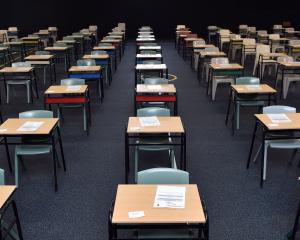Four private schools top the list of those with the highest numbers of candidates receiving support.
Data released by the New Zealand Qualifications Authority under the Official Information Act shows the authority expected to spend $433,000 nationally on the provision of Special Assessment Conditions (SAC) in 2012, compared with $274,160 the year before.
Authority chief executive Dr Karen Poutasi said the recognition of dyslexia by the Ministry of Education as a specific learning disability, and a series of workshops in 2011 aimed at ensuring schools made appropriate applications, led to a rise in applications last year.
A total of 3418 of the 143,000 candidates who sat external NCEA exams qualified for SAC in 2012 - 2535 of them new applicants.
In 2012, this trend held with the top four: St Andrew's College in Christchurch with 89 candidates, Auckland's Diocesan School for Girls (69), St Kentigern College, Pakuranga (61) and Christchurch's Christ's College (55).
In Otago, the school with the highest number of SAC candidates was decile 10 state school Wakatipu High, with 33 applicants, the 13th equal highest number nationally.
Support may be granted to pupils of at least average intelligence who have a physical, medical or learning disability who meet special criteria. Their applications must be supported by an independent report from an ''appropriately qualified registered professional'' or by alternative evidence considered by the NZQA expert panel.
Support could include reader/writer assistance, separate accommodation, extra time to complete the exam, or the use of a computer.
The NZQA pays for most readers/writers, supervisors for candidates in separate accommodation, signing supervisors for hearing-impaired candidates and the cost of extra papers and Braille papers.
Since 2009, candidates have been granted an entitlement for SAC for both internal and external assessment for three years from the date of approval unless otherwise notified. The cost of supporting SAC candidates in internal assessments must be met by schools themselves and some schools seek volunteer help with this.
Asked earlier last year if high decile schools attracted more pupils who needed SAC assistance than lower decile schools, or whether the high numbers of SAC candidates from high decile schools suggested some inequity in the system, Dr Poutasi, in a written response, said all applications were considered against the same set of criteria.
''Anecdotally, some schools appear to have become magnet schools for students with specific learning disabilities because of the programmes they offer (e.g. Western Springs College).''
(In 2012, decile 8 Western Springs had the 14th equal highest number of SAC candidates nationally.)She said it had been more common for lower decile schools to conduct proportionally more internal assessment than their higher decile counterparts. Asked if whether someone got assistance came down to whether they could afford the independent assessment required, Dr Poutasi said there was a system to remove cost as a barrier to accessing SAC for pupils across all deciles.
Schools could make alternative evidence applications, based on appropriate and comprehensive documented evidence or need and/or use of special assessment conditions from the candidate's time at secondary school.
''This option has been taken up by students for whom the cost of an independent assessment is the barrier, by students who have been unable to access an assessment because of a lack of assessors within their area, and by students in their last year of secondary schooling with a previously established entitlement, but whose report is no longer current.''
The information released under the OIA showed that in 2011, 41 alternative evidence applications were considered and 34 of them were granted some or all of the conditions applied for. The other seven were declined. A list linking successful application numbers to the decile ratings of the 328 schools involved shows that a total of six pupils in decile 1 schools received SAC last year (one in each of six schools).
In contrast, 955 SAC candidates were from 41 decile 10 schools. There are higher numbers of pupils in high decile schools.
National roll figures for 2012 show about 15% of all pupils in years 11 to 13 (the years when pupils would be undertaking external examinations) were in decile 10 schools. Decile 10 pupils made up about 28% of all SAC candidates.
Decile 1 to 5 schools had about 35% of the national 11-13 year pupils, but their percentage of SAC candidates was less than half that, at about 16%.
Tables relating school decile ratings to numbers of SAC candidates were not available from NZQA for every year from 2005, but comparisons between 2005 and 2012 show successful application numbers from the high decile schools have increased by hundreds while decile 1 numbers have dropped from double to single figures.
In Otago, only eight of the 26 schools with SAC candidates had 10 or more. They were: Wakatipu High (33), Bayfield High (16), Dunstan High (15), Otago Boys (15), Mt Aspiring College (14), John McGlashan College (13), Kavanagh College (12), Taieri College (10).
The numbers
2012 Special Assessment Conditions applications:
• 2535 new applicants approved.
• 3418 pupils received support in 328 schools
• 182 applications declined
• 1053 applicants had support amended to match evidence the school provided
• 536 appeals to decisions to amend or decline SAC considered
• 455 changes made as a result of appeals
• 89: highest number of SAC candidates from one school.
• 48 schools with only 1 SAC candidate



